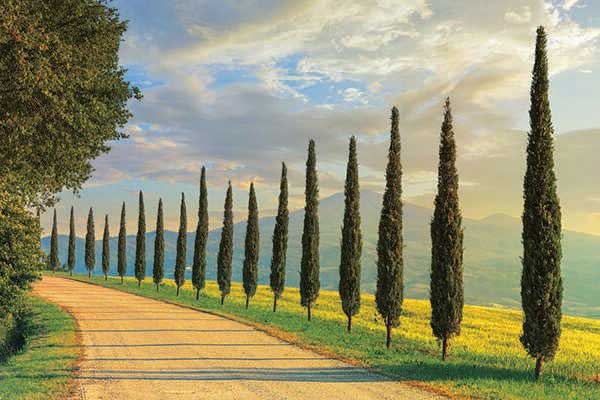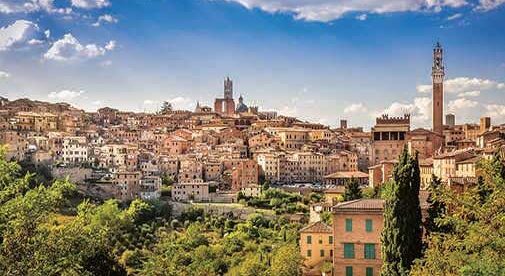I’m in Elettra’s tiny kitchen five floors above Siena, Italy. Things are not going well, and I’m a bit taken aback. This should be simple: Roll a ball of dough into a long thick rope. My rope is oddly lumpy; a far cry from the elegant strands served up in restaurants. Isn’t rolling-out a skill I’d mastered in kindergarten?
I try different pressure along its length; different ways of rolling it on the table. Rolling it between my two palms. Thankfully, my fellow dough-rollers are equally flummoxed. The dough seems foreign in our hands until, all of a sudden, it isn’t. Lines of perfectly formed pasta grow as we lay them out on the well-scrubbed table.
Are you interested in retiring abroad? Yes | Not Sure Yet
These thick ropes are destined to join others in Siena’s signature pasta dish, pici. This will be followed by a large piece of wild boar. It’s been slowly cooking away in a copper pot after marinating for the day. Earlier, in our school’s kitchen, Elettra added red wine to the boar’s marinade, along with thyme sprigs, garlic, and celery. She also threw in a few whole, unshelled walnuts. She tells us these are to make the boar less bitter. I consider this. No amount of walnuts would make me less bitter about finding myself in Elettra’s pot.
I’m the sole American around the table. I’m here with two Italian language instructors, and three new-found friends—an Australian, a Montrealer, and a Brit. That sounds like the beginning of a joke. And, indeed, my fellow students and I are having a great laugh. Amazingly, we’re doing it in Italian.
My fellow students and I are having a great laugh.
So far, I’ve had just three weeks of instruction at Saena Iulia, Siena’s school of language and culture. Even though I’m just a beginner, I understand just about every word spoken by these more advanced students. I’m speaking a good amount myself, and I’m delighted. This informal cooking experience is delicious—for flavor, for friendship, and a sense of accomplishment. I can simultaneously roll dough and speak Italian!
When planning my solo move to Europe, two countries made the shortlist: Ireland and Italy. Ireland tipped into favor because of our shared language. I’ve had five very happy years here, and plan to stay. Still, I often find myself longing for the Tuscan sun. I’d like to be as immersed in Italy’s culture as I am in Ireland’s. Lucky for me, Siena is just a short plane trip away. So, that’s where I headed for a full language learning experience.
I jump feet first into the school’s Monday morning meet-and-greet. This is when new and returning students are welcomed, assessed, and launched into their learning. About 12 of us students and teachers are gathered in one of the school’s high-ceilinged classrooms. Just outside the window is the magnificent layer cake of a cathedral they call the Duomo.
But just my luck, everyone else here—to varying degrees—is much more experienced. I’ve had just some basics, learned from a few weeks with a language app. Not having conversational Italian makes me uncharacteristically nervous and shy. While the others chat around me, I stare into my little shot glass of espresso and then roam the room pretending to study the pictures on the wall—anything to avoid talking.
Eventually, one of the teachers gently engages me. We return to the other students. And somehow I manage to communicate. It will be okay.
The teachers then spirit away some students to assess their language skills. We’ll each have our turn. Until then, we’re left on our own. We commandeer the sofa and claim it as the English-speaking safe zone. We get to know each other much better over the course of our individual stays, but for now, reverting to English is comfortable and informative.
There’s Elizabeth from Amsterdam. Loretta and Susan from Australia. Richenda, who splits her time between Italy and London. Jean, the Montrealer. Helmut from Germany, and others. They each have their own reasons and passions for learning to speak Italian.
Soon enough, it’s time for Sabrina to assesses my skills. For this week, at least, I’m the only beginner. Sabrina will be my teacher for the first few days. She’s pleased I’ve brought the flash cards I’d made from my internet study.
My days with Sabrina will be followed by lessons with Mauro, the school’s founder. Over the next three weeks, I learn that it’s not just business with Mauro. This school and its students are an integral part of his life—both inside and outside of school hours.
I’m delighted by this patient and cheerful man. He leads me into the language with logical progression and simple conversations.
I get all the conversation I can handle the following evening, at one of the local experiences Saena Iulia excels at. Students and teachers meet at the lovely Fonte Gaia, the fountain on Siena’s Piazza del Campo. It’s here on the Campo that the famous Palio horse race is run twice a year, in July and August. But tonight, it’s simply a warm October evening.
The tourists are mostly gone, and the Campo is quietly buzzing with Sienese life: Conversation at tables, and couples walking hand in hand. Families dawdle on the warm red paving bricks while their kids kick footballs or dance to music piped from al fresco restaurants.
We follow Mauro to one of the many outdoor cafés that line the top edge of the Campo. At the bottom edge, the Town Hall, with its flamboyant clock tower, offers an elegant backdrop for our drinks and conversation. We settle ourselves under the canopy.
Waiters take our drink orders and bring plates of food in succession: thin crust pizza with tomato, basil, and mozzarella; bowls of olives; chunks of Peccorino, and an assortment of bruschette with tomatoes or paté. On this second day, I’m still not understanding much of what’s being said, but the delightful hum of conversation and laughter flows around me. I feel as close to being Italian as I’ve ever felt.
The chat might be a bit beyond me, but I know that not-knowing is an important part of the process. I clearly feel myself absorbing the natural cadences of Italian; its sentence structure, some words and their meanings. It’s something I won’t fully understand yet, but at the end of my three weeks, I’ll know just how this first gettogether will serve to benchmark my own progress.
Until then, there will be the lessons, afternoon Tuscan excursions, evening walking trips around Siena, olive harvesting, pizza-making, and shared lunch or pranza—a Friday tradition. My favorite excursion is to the beautiful Abbey of Sant’Antimo, the former Benedictine monastery. I love its quiet, simple beauty, and the carved stonework of animal and vegetable motifs. This includes a most unusual carving of Daniel in the Lions’ Den by the mysterious 12th-century sculptor known only as the Master of Cabestany.

Our cathedral visit is followed by a trip to a vineyard (always church before wine, Mauro tells us). Here we see how this small vineyard produces its wine, and even better, get to sample it. On the way back to Siena, we stop at Montulcino and poke our noses into the shops that line its old-world streets. As we head to the cars, the town has a magical surprise for us. A fiery sunset sizzles behind the dark Tuscan hills.
I get compliments when I talk to locals.
Of course, I have time on my own, too. I’m delighted at how different having the local language makes this visit feel. I’m usually a bit of a rambler. I enjoy absorbing a city’s atmosphere, watching people, and taking in the architecture, scents, and shops. Now, there seems to be more purpose to my rambling. I find myself reading shop signs, and eavesdropping on conversations. I get smiles and compliments from the locals when I converse with them.
School starts at nine, long before Siena’s tourists are out. I’m staying just outside the city walls. With Siena being a hilltown, that means I’ll ride seven escalators to the top every day. It’s a thrill to step off the mechanical staircase and enter a world of ancient streets with their centuries-old buildings. A woman calls from the balcony to her husband in the street below. Laundry hangs neatly along the sides of buildings. A street cleaner pushes his broom as shop owners set up their sidewalk displays.
Except for a few vehicles, Siena is a car-free zone. Italy’s quirky little work trucks always give me a bit of a thrill as they motor past. One day I’m a bit late, and even that has its charms. The Duomo’s bells seems to toll a gentle and melodious scolding as I rush by.
I was lucky to land at Saena Iulia. My fellow students remark at how different it is from their time at other Italian language schools. Unlike some schools, Mauro keeps his groups small—a ratio of six students per teacher. My friends also tell me that at other schools, there is a bigger separation between teachers and students, meaning that once school was over, it was over. Not so at Saena Iulia. I really appreciated how much Mauro and his teachers made us all a part of their after-school social lives.
I’m back in Ireland now, and still serious about my Italian language learning. I’ve found a native Italian speaker in nearby Limerick. I’m with her for 45 minutes each week. I’ve booked a flight back to Siena for another couple of weeks soon, and I’m hoping to spend an entire month there next time. Che bello!
Related Articles
Move to Italy and Enjoy La Dolce Vita (the Sweet Life)
Italy Itinerary: A Journey Through Southern Italy
Upcoming Conferences
The Only 2024 Fast Track Panama Conference
If your dream retirement involves stunning beaches… lush green mountains… a warm climate with no hurricanes… first-rate healthcare… incredible value for money (a couple can live well on $2,200 a month)… and the World’s #1 Retiree Discount Program…
Join our Panama experts and expats in February and discover why Panama could be your perfect paradise.
REGISTER NOW, SEATS LIMITED: EARLY BIRD DISCOUNT HERE


.png)